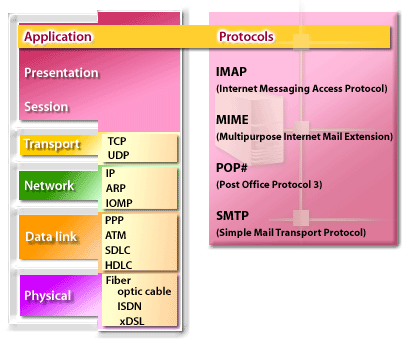| Lesson 7 | Email protocols |
| Objective | Name the protocols used for email. |
Name Protocols used for Email
Email is one of the most widely used communication technologies in the world, and it relies on a number of protocols to function properly. The primary protocols used for email are:
Overall, these protocols work together to enable the sending, receiving, and accessing of email messages. While email may seem simple on the surface, it is actually a complex system that relies on a number of technologies and protocols to function properly.
- Simple Mail Transfer Protocol (SMTP): SMTP is used to send outgoing email messages from one mail server to another. When a user sends an email, the email client uses SMTP to connect to their mail server and transmit the message to the recipient's mail server.
- Internet Message Access Protocol (IMAP): IMAP is used by email clients to retrieve email messages from a mail server. It allows users to access their email messages from multiple devices and keeps the messages stored on the server, so they can be accessed from anywhere.
- Post Office Protocol (POP): POP is another protocol used by email clients to retrieve email messages from a mail server. Unlike IMAP, it downloads messages from the server to the local device, so they can only be accessed from that specific device.
- Multipurpose Internet Mail Extensions (MIME): MIME is a protocol used to add multimedia content to email messages, such as images, audio, and video.
- Domain Name System (DNS): DNS is not specifically an email protocol, but it plays a critical role in the functioning of email. DNS is used to translate domain names (such as google.com) into IP addresses that can be used to route email messages between mail servers.
Overall, these protocols work together to enable the sending, receiving, and accessing of email messages. While email may seem simple on the surface, it is actually a complex system that relies on a number of technologies and protocols to function properly.
Protocols used by email Systems
Email is also governed by protocols. Without most users realizing it, whenever they send or receive an email there are specific protocols that go to work to ensure delivery or receipt. This lesson focuses on the four most common email protocols in use today: IMAP, MIME, POP3, and SMTP.
IMAP
Internet Messaging Access Protocol (IMAP) is a standard mail server that:
- Stores messages until users log on and download the messages
- Allows messages to be archived in folders, mailboxes to be shared, multiple mail servers to be accessed
- Allows users to read only a message header without having to accept the message
MIME
Multipurpose Internet Mail Extension (MIME) is a standard email protocol that:
- Identifies the type of information in a message or document
- Detects and transfers non-text data (such as colors and pictures in email messages) in an email file for email readers, Web servers, and browsers
POP3
Post Office Protocol (POP3) is a standard mail server that:
- Almost all Internet mail readers use POP; for example, Eudora, Netscape, and Outlook
- Holds incoming email until users log on and download it via email clients
- Does not encrypt messages
SMTP
Simple Mail Transport Protocol (SMTP) is the standard TCP/IP email protocol that:
- Sends and forwards email to and between email servers over the Internet
- Does not encrypt message

- Transport (TCP, UDP);
- Network (IP, ARP, IOMP);
- Data link (PPP, ATM, SDLC, HDLC),
- Physical (Fiber optic cable, ISDN, xDSL)
In the next lesson, you will learn about the protocols used on the Web.
Remote Access Protocols email Protocols
Click the Exercise link below to demonstrate your ability to identify the proper function of various protocols.
Remote Access Protocols email Protocols
Remote Access Protocols email Protocols
AWS Certified Networking